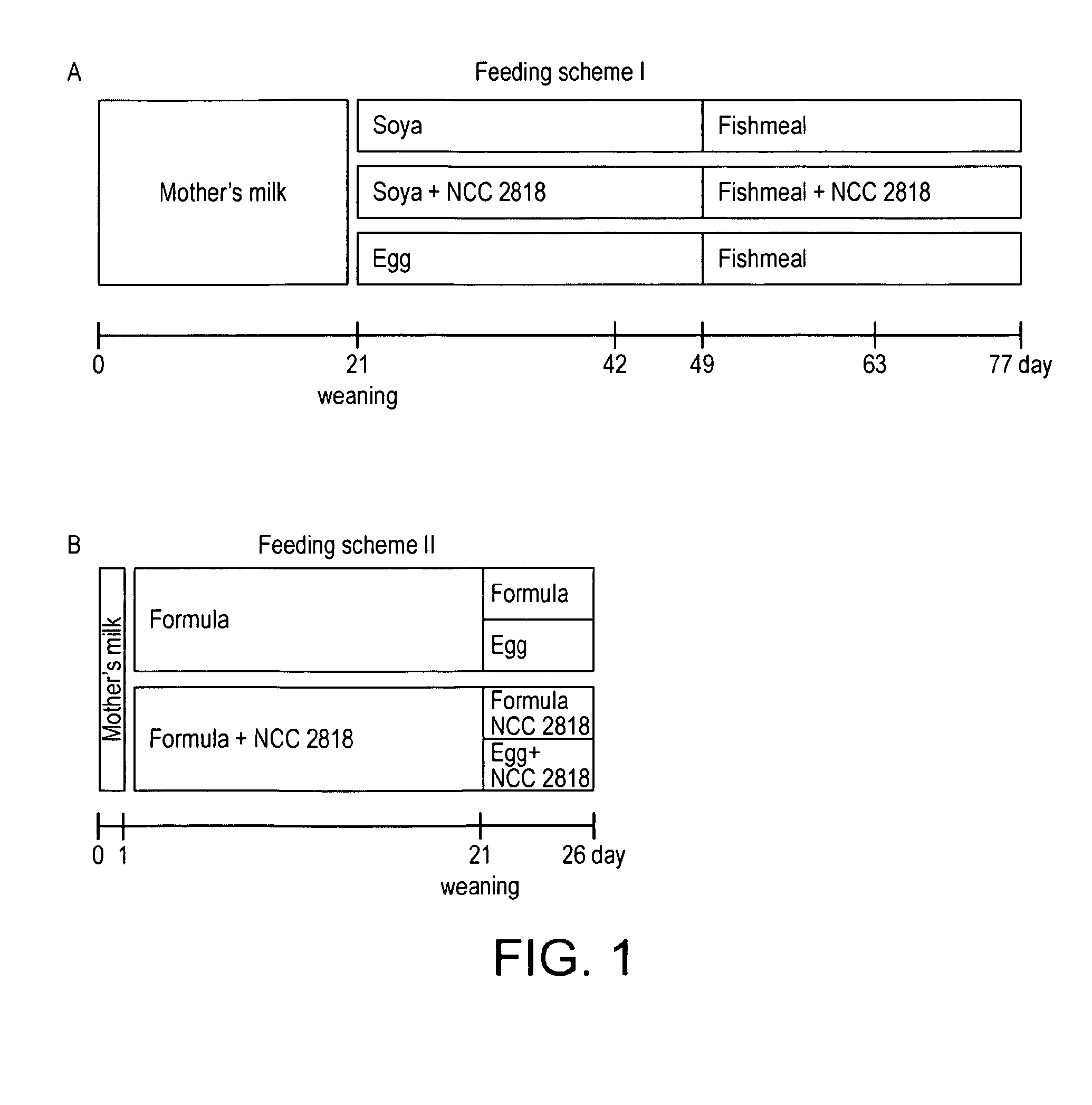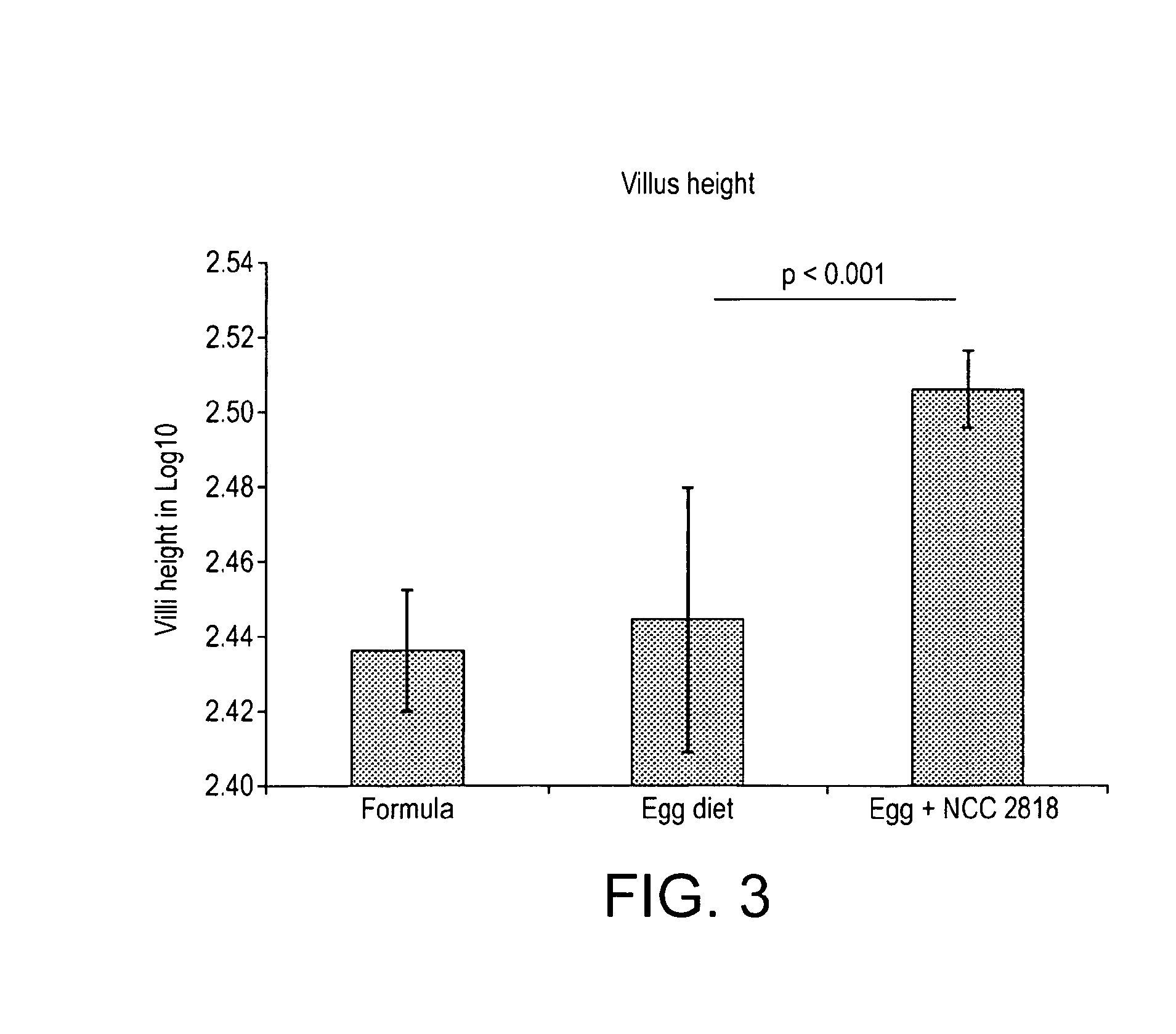Probiotic for administration to healthy young mammals during the weaning period for improving tolerance to newly introduced food stuffs
a weaning period and probiotic technology, applied in the field of improving tolerance in young mammals, can solve the problems of increased risk of weaning, so as to prevent or reduce the symptoms of lack of tolerance to newly introduced food during weaning, enhance the transient increase in humoral immune response, and prevent pathological states
- Summary
- Abstract
- Description
- Claims
- Application Information
AI Technical Summary
Benefits of technology
Problems solved by technology
Method used
Image
Examples
example 1
Piglet Model to Investigate the Impact of B. Lactis NCC2818 at Weaning
[0088]Two Experiments were Carried Out.
[0089]In the first experiment according to Feeding scheme I, (FIG. 1A) for the first three weeks of life, piglets were left suckling with their mothers. At week 3, animals were weaned on solid food with protein content based either on soya supplemented with B. lactis (NCC2818) or non-supplemented soya, or onto a non supplemented ovalbumin (OVA) diet. All animals were switched to a fishmeal diet at 7 weeks, with one group maintaining supplementation with B. lactis NCC2818. Animals were sacrificed at 11 weeks.
[0090]Levels of systemic soya specific IgGs were measured at 0, 7 and 14 days post weaning (FIG. 2), and levels of IgA, IgM and CD21 were examined in mesenteric lymph node (MLN) cells (FIG. 4) at sacrifice.
[0091]In the second experiment according to Feeding scheme II, (FIG. 1B) piglets were fed formula, which was either supplemented with B. lactis NCC2828 or not supplement...
example 2
[0113]Starter Formula
Nutrientper 100 kcalper litreEnergy (kcal)100670Protein (g)1.8312.3Fat (g)5.335.7Linoleic acid (g)0.795.3α-Linolenic acid (mg)101675Lactose (g)11.274.7Prebiotic (100% GOS) (g)0.644.3Minerals (g)0.372.5Na (mg)23150K (mg)89590CI (mg)64430Ca (mg)62410P (mg)31210Mg (mg)750Mn (μg)850Se (μg)213Vitamin A (μg RE)105700Vitamin D (μg)1.510Vitamin E (mg TE)0.85.4Vitamin K1 (μg)854Vitamin C (mg)1067Vitamin B1 (mg)0.070.47Vitamin B2 (mg)0.151.0Niacin (mg)16.7Vitamin B6 (mg)0.0750.50Folic acid (μg)960Pantothenic acid (mg)0.453Vitamin B12 (μg)0.32Biotin (μg)2.215Choline (mg)1067Fe (mg)1.28I (μg)15100Cu (mg)0.060.4Zn (mg)0.755B. Lactis NCC28182 × 107 cfu / gof powder
example 3
[0114]Growing Up Milk Compositions
Nutrientper 100 kcalEnergy (kcal)100100100100100100Protein (g)2.72.222.232.32.92.26Whey / Casein23 / 7740 / 6040 / 6040 / 6077 / 2340 / 60CHO (g)12.213.513.113.011.913.9Lactose (g)5.056.76.14.94.425.33Maltodextrine4.995.85.54.92.312.35(g)Starch (g)1.01.02.92.293.17Sucrose (g)1.932.662.41Fat (g)4.54.144.314.34.533.93Prebiotics (g)0.580.580.520.49B. Lactis2 × 107 cfu / g of powderNCC2818
[0115]Further supporting evidence for the present invention is to be found in the paper “Weaning diet induces sustained metabolic phenotype shift in the pig and influences host response to Bifidobacterium lactis NCC2818C” (Merrifield and M. Lewis et al., 2012, Gut doi:10.1136 / gutjnl-2011-301656), herewith incorporated by reference. Particular reference to FIG. 3 panel A of Merrifield and M. Lewis eta / is made. The data shown in Merrifield and M. Lewis et al provide evidence that a probiotic, specifically Bifidobacterium animalis subsp. lactis, has an effect on immune adaptation when ad...
PUM
 Login to View More
Login to View More Abstract
Description
Claims
Application Information
 Login to View More
Login to View More - R&D
- Intellectual Property
- Life Sciences
- Materials
- Tech Scout
- Unparalleled Data Quality
- Higher Quality Content
- 60% Fewer Hallucinations
Browse by: Latest US Patents, China's latest patents, Technical Efficacy Thesaurus, Application Domain, Technology Topic, Popular Technical Reports.
© 2025 PatSnap. All rights reserved.Legal|Privacy policy|Modern Slavery Act Transparency Statement|Sitemap|About US| Contact US: help@patsnap.com



